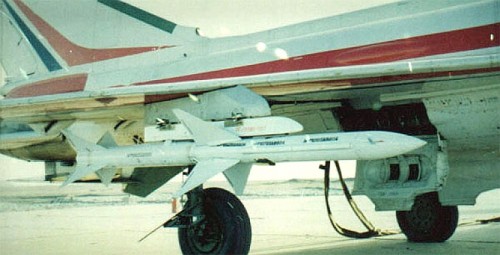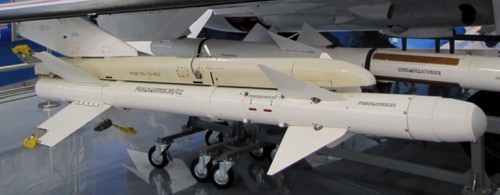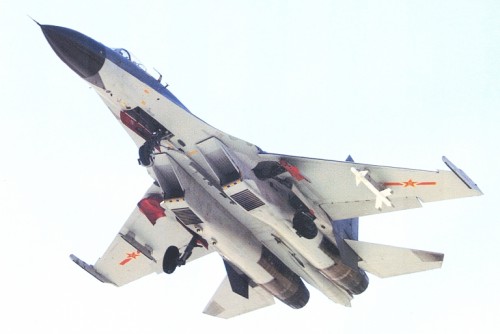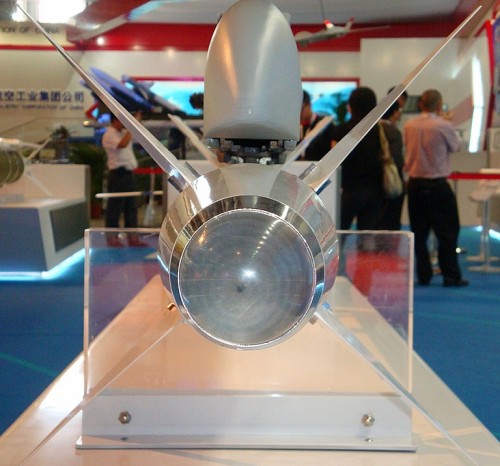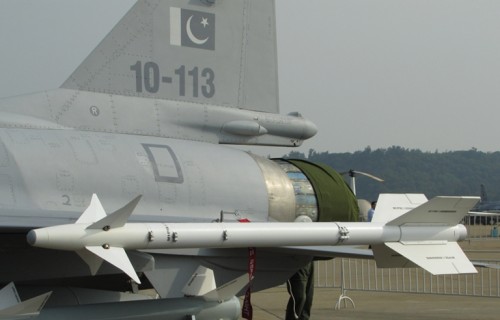China’s Emerging 5th Generation Air-to-Air Missiles
Email this article
Print this article
by
Richard Fisher, Jr.
Published on February 2nd, 2008
ARTICLES
Internet source imagery from January 4 has offered the first glimpses of what may be China’s emerging 5th generation air-to-air missiles (AAM). One missile, called the PL-ASR or PL-10, shows a very close resemblance to the South African Denel A-Darter AAM. A second image, discovered on a China’s Northwestern University web site in mid-December, shows another missile similar to the radar-guided South African Denel R-Darter, designed in cooperation with Israel. Both of these missiles are likely designed for use with modern Helmet-Mounted Displays (HMD), which enable pilots to “look to kill” their targets. But there is more: additional imagery suggests that a previously reported ramjet powered development of the Chinese Luoyang PL-12 active-radar guided AAM, called the PL-13, could give the People’s Liberation Army (PLA) an AAM that could out-range existing U.S. AAMs.[1]
Luoyang PL-ASR/PL-10: This image obtained from Chinese web pages on January 4 was the first revelation of the existence of the advanced PL-10 5th generation AAM. The text indicates development began in 2004 and production is expected by 2010. The missile also has a 90 degree off-bore-sight view and a “Lock On After Launch” capability, meaning it can better exploit high off bore-sight firing. Source: CJDBY web page.
Data along with one image suggests the PL-10 could enter production in 2010 but it is not known when the other two new AAMs would enter production. When they do enter service, these AAMs could give both old and new PLA Air Force fighters a decisive advantage over Taiwan Air Force fighters armed with shorter range U.S. AIM-9 Sidewinder and AIM-120 AMRAAM missiles. The PL-ASR/PL-10 could have up to double the range of the new U.S. AIM-9X, the first U.S. HMD sighted AAM, which is just now entering service with U.S. Air Force and Navy squadrons. The ramjet powered “PL-13” may out-range current variants of the AIM-120.
Absolute determination of AAM capabilities is greatly hampered by the efforts of governments and manufacturers to deny information, such as that regarding missile range and countermeasures, which would allow potential adversaries to gain an advantage.[2] Furthermore, the utility of an AAM is also determined by many attributes of the carrying aircraft: its radar and electronic support systems, the availability of off-board sensor data, and the degree of training and experience of the launching pilot. But there is little margin for error when considering a major factor such as weapons, especially when considering that China’s increasing numbers of competitive 4th generation combat aircraft may be followed by 5th generation combat aircraft early to mid-next decade. Absent a U.S. response, such as the purchase of more 5th generation fighters, the development of a new generation of AAMs, or even the purchase of more capable European AAMs, the air power balance in Asia could shift dangerously toward China.
5th Generation Short Range Air to Air Missiles
Since the 1940s the progress of combat aircraft and their weapons have been measured in “generations.” The latest 5th Generation combat aircraft, of which the U.S. Lockheed-Martin F-22A Raptor is the only one operational, are defined usually by their ability to combine the attributes of stealth, advanced electronically scanned (AESA) radar, and engines powerful enough to cruise supersonically without recourse to fuel-guzzling afterburners (super-cruise). These capabilities give the F-22A the ability to detect and attack before being detected, and to evade new and deadly Russian surface-to-air missiles. But since their introduction in the 1970s, American, Russian and other manufacturers have been constantly upgrading their 4th generation fighters such as the Boeing F-15 Eagle and the Sukhoi Su-27/30 Flanker with ever more modern electronic systems and weapons.
In the 1980s Russia began the trend toward the 4th generation AAMs with the introduction of the Vympel R-73, the first thrust-vectored AAM with a 45-degree off-bore-sight view (90-degree field of view) infrared seeker, and the ability to be targeted with a helmet-mounted sight (HMS). This gave Soviet-Russian fighters a decisive advantage over U.S. and European fighters: the Soviets could always launch their short-range AAMs first as they did not have to orient or “dogfight” their fighter, but merely needed to “look” at the target to direct the R-73 AAM. This technology has evolved into a 5th generation defined by the inclusion of more sensitive imaging-infrared seekers that home in on a specific part of the target aircraft; seekers with wider 90-degree off-bore-sight view(180-degree fields of view); seekers that incorporate advanced anti-jamming and anti-decoy technology; and those which use more advanced helmet-mounted displays. Examples of 5th generation infrared guided AAMs include the British ASRAAM, German IRIS-T, Israeli Python-5, Japanese AAM-5, U.S. AIM-9X, the improved Vympel R-73 and the South African A-Darter. Should a longer range 5th generation AAM like the Python-5 miss its target on the first pass, it usually has the range and agility to attack once more.

MBDA’s Modern AAMs: The ASRAAM short-range and Meteor long-range AAMs seen at the recent Dubai Airshow. Source: RD Fisher
While first generation short range infrared guided AAM relied on the pilot to find and maneuver to attack an often rapidly moving target, 4th and 5th generation short-range AAMs rely on aircraft sensors and advanced helmet mounted displays to target these latest AAMs which usually have much greater range than a pilot’s sight. In the 1980s, in addition to using the aircraft’s radar, the Soviets introduced more sophisticated optical infrared search and tracking (IRST) systems, which allowed aircraft to turn off emitting radars which in turn could be targeted by opposing electronic sensors and jamming. The Russian OLS-30 IRST used in late versions of Sukhoi fighters, and Shenyang co-produced Su-27/J-11 fighters, is reportedly able to passively search and track targets out to 50-90km. While Russian IRSTs are reportedly not able to determine range, the Russians apparently network several fighter IRSTs and radar to find the range of targets, even stealthy targets.[3] HMDs are able to collate data from radar, optical sensors, plus aircraft performance data onto the pilot’s helmet visor, allowing him to target distant threats without having to concentrate on cockpit instruments. Israel’s DASH HMD became the basis for the U.S. Joint Helmet Mounted Cueing System (JHMCS) HMD, which support the AIM-9X AAM that in 2003 started entering service on U.S. F-15, F-16 and F/A-18 fighters.

Active Radar-Guided AAMs
While the U.S. has lagged in the development of 5th generation HMD sighted AAMs, it has helped to lead the field in the development of medium range active-guided AAMs. The Raytheon AIM-120 Advanced Medium Range Air-to-Air Missile (AMRAAM) began in 1975 leading to fielding in the early 1990s, while the Vympel R-77 program began in 1982 and first appeared in the early 1990s. Both missiles sought to perfect the advancement of incorporating an active radar seeker to allow the AAM to guide itself autonomously for part of its flight. Previous “semi-active” radar guided AAMs like the AIM-7 Sparrow and the Vympel R-27 required continuous “painting” by aircraft radar with constant radio signals to guide the missile until reaching its target. Active radar guided missiles like the AIM-120 and R-77 still require target location data from the launching aircraft, or more recently, from an off-board sensor like an AWACS aircraft, but after the missile’s active radar acquires the target the launching aircraft has the option to maneuver to safety or commence another attack.


AIM-120D and R-77: The AIM-120D is the latest model of the AMRAAM due to enter service soon, whereas China may have purchased up to 1,000 of the Vympel R-77 AAM. Source: US Air Force and RD Fisher
The AIM-120, the Russian R-77 and the French MICA dominate the market for active-guided AAMs. In this decade Japan, China and Taiwan have fielded active guided AAMs, with the latter two relying on imported technology. All active-guided AAM makers have sought to improve their products with better seekers, some using satellite navigation guidance, enhanced electronic counter measures, the addition of data links to provide updated target location data, and better engines to enable longer range. The U.S., Russia, Europe, South Africa, and perhaps more recently China, have developed ramjet engine powered AAMs to achieve longer ranges without increasing missile size. Ramjets also allow the missile to sustain its high speed over most of its range, which significantly expands the “no escape zone” or area within which a target will likely be killed. The only ramjet powered AAM soon to enter service is the MBDA Meteor, which advertises a 100+km range, and a constant Mach 4+ speed and a “no escape zone” three times that of early AIM-120 AAMs.[4] More recently Russia has revived its very long range missile program with the Novator K-100 or K-172, which has been variously reported to have a 200km to 400km range. The last U.S. very long range Hughes AIM-54C Phoenix, capable of reaching 150km, was retired from U.S. Navy service in 2004. While the U.S. had two-stage and ramjet missile engine AAM test programs in the 1980s and 1990s,[5] it has chosen not to replace the long range AIM-54C.

China’s Record of Foreign AAM Technology Reliance
Almost from the beginning the PLA has relied on foreign technology, whether from the United States, Russia, Israel and now South Africa, to develop ever more modern air-to-air missiles. In September 1958 a U.S. AIM-9B Sidewinder short range air-to-air missile (AAM) was captured by China after it was fired by a Taiwanese F-86 Sabre fighter at a Chinese MiG-17, becoming lodged in the airframe without exploding. At the time the AIM-9B was the most modern air-to-air missile anywhere and it was soon copied by the Soviet Union and China. For the Soviets it became the K-13 (NATO: AA-2 Atol) and for China the PL-2 (PL meaning Thunderbolt). During the Vietnam War China was able to obtain unexploded copies of more advanced AIM-9 missiles, which influenced the PL-5, as well as early version of the Raytheon AIM-7 Sparrow, which influence the radar-guided PL-11. During the 1980s China obtained the French Matra 550, which was copied as the PL-7 and the Israeli Python-3, which was copied as the PL-8.
From the 1990s to the present period the PLA has purchased thousands of modern Russian AAMs, including the Vympel R-73 short-range AAM, and multiple variants of the semi-active radar and infrared guided Vympel R-27 medium range AAM. In addition the PLA has purchased about 1,000 of the more modern active radar guided Vympel R-77 medium range AAM. These missiles almost exclusively arm Sukhoi/KnAAPO made Su-27SK/Su-30MKK/MKK2 fighters or the Shenyang Aircraft Co. co-produced version of the Su-27SK called the J-11, or J-11A. It has been reported that some number of early purchase Su-27SKs and early J-11s were upgraded in order to be able to fire the R-77, whereas the Su-30s had this capability from delivery.
Starting in the 1990s, as it did with other weapons purchases, the PLA decided to purchase the underlying technology of weapons systems or their components, so as to make weapon systems with increasing indigenous Chinese content. By the mid 1990s China’s main missile maker Luoyang had developed the PL-9, which took the fuselage of the Python-3, attached different guidance fins, and incorporated a copy of the Ukrainian Arsenel helmet sight, called the TK-14 in Chinese service, to make a new AAM.[6] The latest PL-9C features an increase in range to 22km, up from 15km for the PL-9, PL-8 and Python-3 AAMs. One mystery has been why the PL-9 has not seen widespread usage in the PLA air forces. From the 1996 Zhuhai show and at subsequent shows, Luoyang officials have noted to the author that the PLA was not interested in buying the PL-9, even though it has occasionally been seen on some fighters like the late model Chengdu J-7G.
PL-9C and HMS: It is not clear that the PL-9C AAM with the TK-14 helmet sight is in widespread PLA service, an indication that the PLA was instead waiting for a more advanced short-range AAM. Source: RD Fisher
Perhaps a key reason for not purchasing the PL-9 has been the expectation that the PLA would be building an even better AAM. At the 2002 Zhuhai Airshow Luoyang officials told this analyst and other reporters that the company was working on an advanced AAM. The few details disclosed, such as advanced guidance, the use of thrust vectoring and helmet displays created a basis for speculation that Luoyang was interested in an AAM like the British ASRAAM. Despite the heavy reliance on purchased Russian short range AAMs like the R-73, the inspiration for Luoyang’s 5th generation AAM was to come from elsewhere.
Possible “South African” AAMs
At the 2002 Zhuhai Airshow South African firms set up a small booth and spoke of their desire to do business with the PLA but did not go into specifics. At subsequent shows the South African presence grew larger and it is now clear that there have been several cooperative programs, including unmanned aircraft, air defense systems and air to air missiles. While South African firms have said little about the latter, in 2004 Yihong Chang reported on PLA interest in purchasing the 5th generation Denel A-Darter AAM.[7] The data revealed on January 4 indicated that development of the PL-10 started in 2004, which might track very well with the reported deepening of South African-PLA cooperation. The few clear images of the PL-ASR/PL-10 show a near 95 percent similarity with the Denel A-Darter AAM. The main differences are in the rear fin shape and configuration, but it is a relatively minor difference. So it is possible to speculate that the PL-10 may very well have a performance similar to or better than the A-Darter, which would include use of advanced imaging infrared guidance and a maximum range of 20km or better. The January 4 revelation indicates the seeker has a 90-degree off-bore-sight capability (180 degree field of view). It also has a lock-on-after-launch capability, meaning it can be launched from a high off-bore-sight position and acquires the target, usually accomplished with the aid of a helmet sight or IRST.











